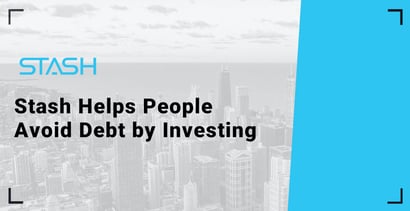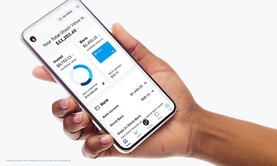

In a Nutshell: Thanks to advances in technology, investing is no longer limited to the wealthiest members of society. Stash is a company that is democratizing investing and making it easier than ever for the average person to build wealth. This also makes it easier for consumers to have a financial safety net for emergencies in place of relying on credit or falling into debt. Stash operates on the simple philosophy that everyone should have access to investing. The company also provides the innovative Stock-Back Card, which functions like a regular debit card, but instead of rewards, users are rewarded with stock just by making their everyday purchases.
For decades, investing in the stock market was a financial strategy largely available only to the most affluent people in the U.S. The barriers to entering the world of investing were high.
Members of the upper echelons of society could afford to pay a brokerage firm to invest funds on their behalf. Lower and middle-income folks were usually unable to take advantage of this money growth strategy because investing required a hefty chunk of change to even enter the game.
 Thanks to a number of innovative fintech startups and advances in technology, investing is no longer limited to the upper class. Nearly anybody can begin investing and see real results.
Thanks to a number of innovative fintech startups and advances in technology, investing is no longer limited to the upper class. Nearly anybody can begin investing and see real results.
Of course, investing in securities is a great way to grow your money and give yourself a financial safety net. Once a person has just a few hundred dollars invested in stocks, those funds can serve as a financial safety net and alternative to falling into debt.
And, although we’ve mentioned it here before it bears repeating — carrying financial debt can lead to a number of negative consequences. Experts have shown how debt leads to increased stress which in turn can manifest in physical ailments. Stress can also lead to high tensions in relationships and reduce the quality of life in households impacted by debt.
Thankfully, consumers can greatly benefit from an app like Stash that makes investing extremely easy.
We recently spoke with Stash CMO Dale Sperling to learn more about the innovative app, its Stock-Back Card, and the company’s mission to make investing accessible to all.
Establishing a Platform to Help the Average Consumer Invest and Build Wealth
Sperling said that Stash was founded in 2015 by Brandon Krieg and Ed Robinson. And since day one, the company has been on a mission to help everyday Americans invest in themselves and build long-term wealth.
“For too long, a majority of Americans have lacked access to easy and affordable financial tools,” Sperling said. “Instead, many incumbent financial institutions rely on excessive fees and high minimums, keeping hard-working Americans on the sidelines.”
This is why the Stash platform is rooted in education, easy-to-use tools, and personalized guidance, she explained.

Dale Sperling is the Chief Marketing Officer at Stash.
Stash is a personal finance app that simplifies investing and makes it easy and affordable for average people to build wealth and achieve their financial goals, according to the Stash website.
“Stash was built with a simple philosophy: everyone should have access to investing,” according to the company. “Thanks to fractional shares, anyone can invest in the stock market with $5 or less. And along with other investing and saving tools, like the Stock-Back® Card, Stash helps more than 5 million people reach their financial goals.”
Stash offers three plans for users to choose from.
“Starting at just $1 a month, Stash’s unique subscription model is designed to help anyone build wealth, hit financial goals, and invest in themselves,” Sperling said. “Each plan includes access to investment accounts, no-hidden-fee banking with the Stock-Back® Card, budgeting and saving tools, personalized guidance, and more.”
Stash users will bear the standard fees and expenses reflected in the pricing of the ETFs in your account, plus fees for various ancillary services charged by Stash and the custodian, according to the company. Complete information can be found in the company’s Advisory Agreement and its Deposit Account Agreement.
The Stock-Back Card Allows People to Invest in Their Financial Well-Being
Stash’s Stock-Back® Card, in particular, is reimagining the bridge between banking and investing by rewarding customers with fractional shares of stock when they spend using the card, Sperling said. This enables people to invest as they go about their daily spending.
“Historically, many reward-driven cards have been designed to make customers spend more. Or the rewards expire before being put to use,” Sperling said. “Stash’s Stock-Back® Card helps customers invest in themselves as they spend on life’s necessities or at their favorite brands — plus, unlike points, the pieces of stock grow with a customer over time.”

Stash’s mission is to make investing accessible and affordable to everybody.
There are no credit requirements attached to the Stock-Back® Card, which functions like a regular debit card, but members are required to open and fund a Stash banking account, according to the company.
“When a customer makes a qualifying purchase with the Stock-Back® Card, they earn stock that matches where they shopped,” Sperling said. “Swipe at McDonald’s, earn $MCD; Spotify, earn $SPOT; Etsy, earn $ETSY.”
Customers also earn fractional shares in their choice of more than a dozen qualifying stocks and ETFs, when they shop at their local bookstore or grocery, she said.
Sperling said the company’s goal is to make accessibility to investing a reality for nearly anybody.
“Accessibility and affordability are central to the Stash platform and mission,” she said. “It’s why subscription plans start at a flat, monthly rate of $1 per month, and why Stash’s banking product comes with no hidden fees — including no overdraft of minimum balance fees.”
Customers can invest in stocks and ETFs with as little as $0.01 across personal brokerage, retirement, and custodial accounts, Sperling said.
“More than anything, every Stash customer has access to Stash’s abundance of educational content — from daily articles to weekly newsletters, videos, and more — as well as budgeting and diversification tools,” the CMO explained.
Taking Customer Feedback to Heart
“Nearly every corner of the Stash platform is rooted in direct customer feedback,” Sperling said. “It’s customers’ needs and ambitions that drive new features, app design, and more.”
Stash has a robust user experience research team, as well as weekly call listening sessions with customers. Sperling said the Stash founders also still make it a point to speak directly with customers on a regular basis.
“In 2020, for example, Stash launched Goals — a cash management tool that allows customers to create unique categories within their Stash banking account, helping them better prepare for expenses and more easily allocate money towards their financial goals,” she said.
The genesis of Goals is rooted in direct customer feedback.
“A 2019 Stash study found that each week, at least 35% of study participants faced an unplanned expense, and 44% reported turning to credit cards in those instances,” Sperling said. “Recognizing customers’ need for a better way to partition their money — without the fear of taking on debt — Goals was born.”
Sperling noted that money moved into a Goal must be moved back to the bank account available balance to be used and does not earn interest.
The company launched another service it expects to be popular with users.
“Stash now offers Smart Portfolios, allowing customers to build long-term, diversified portfolios that are fully managed by Stash,” Sperling said. “The new offering — built for the millions of Americans who want to invest, but don’t know where to start — aims to further help customers avoid the risks of day-trading.”
Unlike other institutions, Stash will not charge fees based on portfolio size, she added. Instead, Smart Portfolios will be available to customers as part of Stash’s Growth and Plus subscription plans, starting at $3 per month.
So, if you’ve been curious about investing but aren’t sure how or where to start, Stash may offer the perfect solution to easily get into investing and begin to build your wealth.
Advertiser Disclosure
BadCredit.org is a free online resource that offers valuable content and comparison services to users. To keep this resource 100% free for users, we receive advertising compensation from the financial products listed on this page. Along with key review factors, this compensation may impact how and where products appear on the page (including, for example, the order in which they appear). BadCredit.org does not include listings for all financial products.
Our Editorial Review Policy
Our site is committed to publishing independent, accurate content guided by strict editorial guidelines. Before articles and reviews are published on our site, they undergo a thorough review process performed by a team of independent editors and subject-matter experts to ensure the content’s accuracy, timeliness, and impartiality. Our editorial team is separate and independent of our site’s advertisers, and the opinions they express on our site are their own. To read more about our team members and their editorial backgrounds, please visit our site’s About page.




